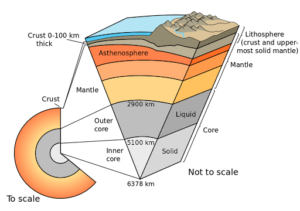In news-A meteor shower near Nagpur in 2012 helped scientists unravel the composition of Earth’s lower mantle.
GSI’s study on this meteor shower
- A large meteor shower occurred in 2012 near the town of Katol in Nagpur.
- The shower caused sonic booms or thunder-like noises, initially spreading rumours that an aircraft had crashed.
- The researchers from the Geological Survey of India collected about 30 meteorite fragments with the largest weighing around a kilogram.
- Initial studies revealed that the host rock was mainly composed of olivine, an olive-green mineral.
- Olivine is the most abundant phase in our Earth’s upper mantle.
- Now, by studying the composition of these meteorite fragments, researchers have unravelled the composition expected to be present in the Earth’s lower mantle which is at about 660 km deep.
- They also say that studying the meteorite could also tell us more about how our Earth evolved from being a magma ocean to a rocky planet.
How did they study the meteorite?
- The researchers took a small sample of the meteorite and examined it using special microscopy techniques.
- The mineralogy was determined using a laser micro-Raman spectrometer.
- These techniques helped the team identify, characterise the crystal structure of the meteorite and determine its chemical composition and texture
Findings of the study
- The international team of scientists examined a section of the highly-shocked meteorite from Katol.
- The paper published this month in PNAS reports the first natural occurrence of a mineral called bridgmanite.
- The mineral was named in 2014 after Prof. Percy W. Bridgman, recipient of the 1946 Nobel Prize in Physics.
- Various computational and experimental studies have shown that about 80% of the Earth’s lower mantle is made up of bridgmanite.
- By studying this meteorite sample, scientists can decode how bridgmanite crystallized during the final stages of our Earth’s formation.

How is bridgmanite on earth different from meteorite?
- The bridgmanite in the meteorite was found to be formed at pressures of about 23 to 25 gigapascals generated by the shock event.
- The high temperature and pressure in our Earth’s interior have changed over billions of years causing crystallisation, melting, remelting of the different minerals before they reached their current state.
- It is important to study these individual minerals to get a thorough idea of how and when the Earth’s layers formed.
- Though previous studies on other meteorite samples (Tenham and Suizhou samples) have shown the presence of much more magnesium and iron components, they were different from bridgmanite present in the Earth’s lower mantle.
- The composition of Katol bridgmanite closely matches those synthesized in different laboratories around the globe over the last three decades.
What is Olivine ?
- Olivine is the name of a group of rock-forming minerals that are typically found in mafic and ultramafic igneous rocks such as basalt, gabbro, dunite, diabase, and peridotite.
- It is named for its typically olive-green color, thought to be a result of traces of nickel, though it may alter to a reddish color from the oxidation of iron.
- Translucent olivine is sometimes used as a gemstone called peridot (péridot, the French word for olivine).
They are usually green in color and have compositions that typically range between Mg2SiO4 and Fe2SiO4.
















